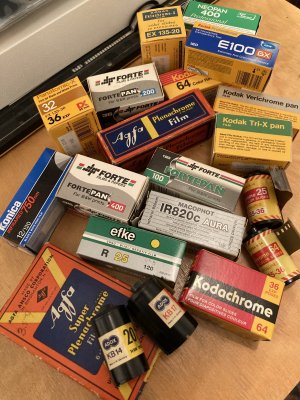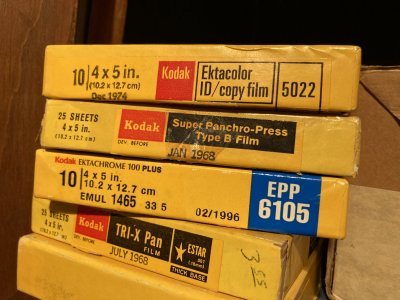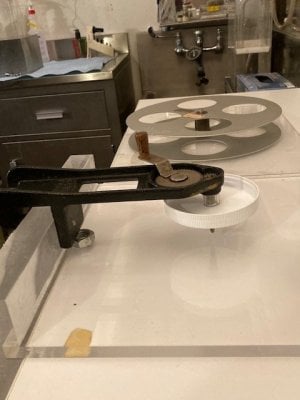Bill Blackwell
Leica M Shooter
I still shoot two or three rolls of film in a year (I have enough film in my freezer to last me two lifetimes) - only because I enjoy it. It's odd, but I seem to enjoy the picture-taking experience far more when shooting any Leica M film camera as opposed to any Leica M digital. However, the results I get from digital are far superior to that of film.
x-ray
Mentor
I remember my dad buying regular gas during a gas war for 14.9/gal. I regularly paid 27.9/gal. I had just bought a new 1973 International Scout II with the 4 speed and 345 V8. My Scout got 8mpg in town and 13 on the highway. Gas went up to 33 cents and remember my dad saying it might eventually get to 50 cents. I about freaked!This topic could apply to almost anything. When I first started driving, gas was ~$0.50 a gallon (that's when they called premium "ethyl").
My first summer job paid $1.90/hr.
x-ray
Mentor
over the past thirty years or so I’ve kept a roll of different emulsions that I used that have been discontinued. It makes me I’ll to see all the great films that are now gone and this only represents emulsions I once used.
Take a look at the price of 4x5 TXP (320asa) from the mid 60’s, $3.55. The Super Pancro Press Type B was also $3.55. If you’re not familiar with Super Pancro it was 250asa (iso for you kids) and was designed for press work. I think it had a toothed base for pencil retouching. I also used Kodak Royal Pan (not Royal X Pan) asa 400. All great films.
Take a look at the price of 4x5 TXP (320asa) from the mid 60’s, $3.55. The Super Pancro Press Type B was also $3.55. If you’re not familiar with Super Pancro it was 250asa (iso for you kids) and was designed for press work. I think it had a toothed base for pencil retouching. I also used Kodak Royal Pan (not Royal X Pan) asa 400. All great films.
Attachments
bob_summers
Member
Ironically I’ve just dropped 3.5k on my first proper digital camera, due to the price of film :/
However, HP5 is about 8€ in 135/36 here, which is about the same as a pint of ale in some places.
I know which I’d rather spend my money on!
However, HP5 is about 8€ in 135/36 here, which is about the same as a pint of ale in some places.
I know which I’d rather spend my money on!
x-ray
Mentor
Anyone know what Ektacolor ID film is? It was for ID badge photography and copy work. Color obviously but it incorporated two emulsions. One was basically a regular Ektacolor professional emulsion and the other had an exaggerated curve giving very high density whites if over exposed by one stop. Essentially one stop over exposure caused whites / highlights near white to totally block up. The purpose was to give clean white backgrounds or clean white areas in portraits or with documents on white paper. For portraits you had to light the background one stop hotter than your subject to keep white clothing from disappearing.
Kodak made a B&W version called Pro Copy in sheet film. Contrast was controlled by exposure not development. Both were excellent films.
Kodak made a B&W version called Pro Copy in sheet film. Contrast was controlled by exposure not development. Both were excellent films.
x-ray
Mentor
Since we have a lot of folks that never shot film or didn’t get into the real depth of film photography here are a few relics from the past.
I still use my Photo Lab index. The PLI was a compilation of data and photo facts. Virtually all film and developers, bulbs, flash bulbs, fixers, stop baths, toners and you name it the formulas and data were here plus specs for hardware. It was a subscription service and manufactures provided new data on products, developers, processing times etc. to PLI and it was incorporated in the book. Updates came out monthly. I don’t remember the cost but it was worth it.
Other professions had similar like for pilots. When I was starting to fly many years ago Jeepsen published volumesike the PLU of approach plates, air traffic info, radio and navigation frequencies and basically anything a pilot could use. Revised pages were sent out monthly with new info to put in your books. It was by subscription too.
Hers my old!!! Lab index from Kodak. It had calculators for various films, developers, times and temps plus printing paper data and more. I still use it and keep old film data sheets and new cartons tucked inside with my notes. The data sheets were included in ever roll of film from Kodak and Ilford. Others did that too. Basically they had all the info you could want including exposure, reciprocity and development.
The next little book is the Master Photo guide from Kodak. It had info on reciprocity, color & B&W filters, filter factors, bellows factors for closeup and a ton more valuable info. It even covered different flash bulbs and a calculator for exposure with them. Nifty!!!
Those calculator wheels were a lot of fun when us was a kid. There was even a set of Wratten fells for Wratten 29, 15, 11 and a few more B&W filters. You could look through them and see the effect in film, sort of.
I still use my Photo Lab index. The PLI was a compilation of data and photo facts. Virtually all film and developers, bulbs, flash bulbs, fixers, stop baths, toners and you name it the formulas and data were here plus specs for hardware. It was a subscription service and manufactures provided new data on products, developers, processing times etc. to PLI and it was incorporated in the book. Updates came out monthly. I don’t remember the cost but it was worth it.
Other professions had similar like for pilots. When I was starting to fly many years ago Jeepsen published volumesike the PLU of approach plates, air traffic info, radio and navigation frequencies and basically anything a pilot could use. Revised pages were sent out monthly with new info to put in your books. It was by subscription too.
Hers my old!!! Lab index from Kodak. It had calculators for various films, developers, times and temps plus printing paper data and more. I still use it and keep old film data sheets and new cartons tucked inside with my notes. The data sheets were included in ever roll of film from Kodak and Ilford. Others did that too. Basically they had all the info you could want including exposure, reciprocity and development.
The next little book is the Master Photo guide from Kodak. It had info on reciprocity, color & B&W filters, filter factors, bellows factors for closeup and a ton more valuable info. It even covered different flash bulbs and a calculator for exposure with them. Nifty!!!
Those calculator wheels were a lot of fun when us was a kid. There was even a set of Wratten fells for Wratten 29, 15, 11 and a few more B&W filters. You could look through them and see the effect in film, sort of.
Attachments
-
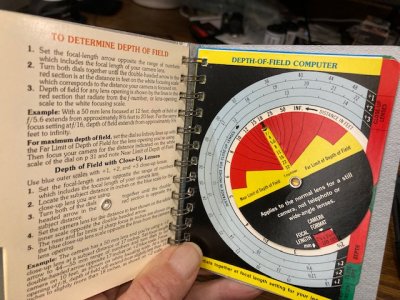 7755F357-6CD4-4E32-A69F-74779A9181FB.jpeg129.7 KB · Views: 6
7755F357-6CD4-4E32-A69F-74779A9181FB.jpeg129.7 KB · Views: 6 -
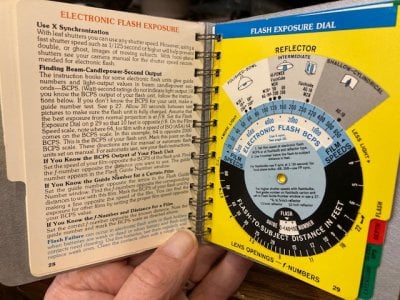 7E3A94A3-DF4D-4477-A40C-CBE4DE13832A.jpeg136.3 KB · Views: 6
7E3A94A3-DF4D-4477-A40C-CBE4DE13832A.jpeg136.3 KB · Views: 6 -
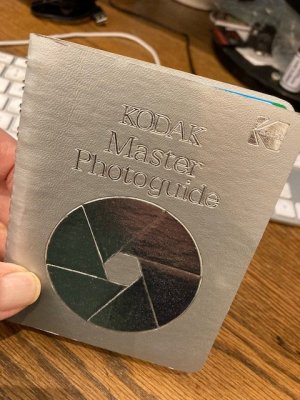 AD178161-57F8-4488-9B86-AA3CF0E42170.jpeg88.8 KB · Views: 5
AD178161-57F8-4488-9B86-AA3CF0E42170.jpeg88.8 KB · Views: 5 -
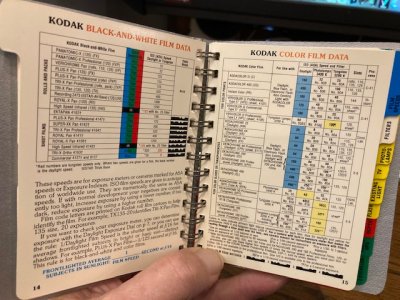 DF977FAA-549F-4926-B829-5FFCF2AE8341.jpeg130 KB · Views: 5
DF977FAA-549F-4926-B829-5FFCF2AE8341.jpeg130 KB · Views: 5 -
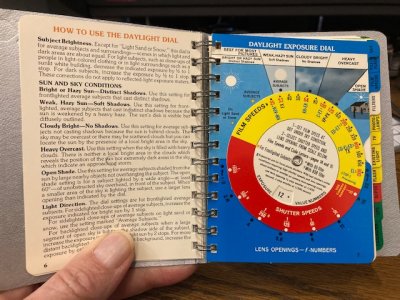 6876015A-7B97-4F13-B744-7793A9B2AE98.jpeg135 KB · Views: 5
6876015A-7B97-4F13-B744-7793A9B2AE98.jpeg135 KB · Views: 5 -
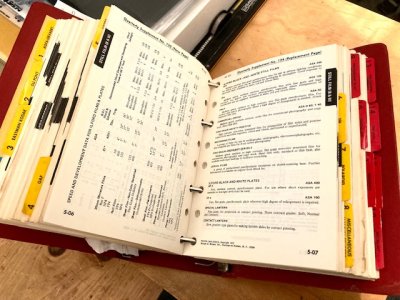 DB1A6742-D3DF-483F-AAB7-C3D2746283C3.jpeg113 KB · Views: 6
DB1A6742-D3DF-483F-AAB7-C3D2746283C3.jpeg113 KB · Views: 6 -
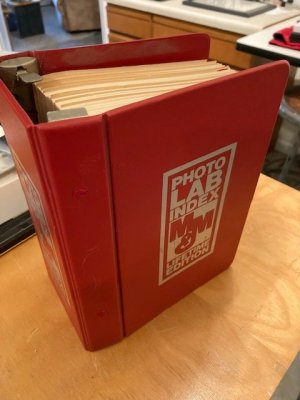 3D56E0B7-76B7-4E56-ADCF-C8D618FFB445.jpeg52.1 KB · Views: 6
3D56E0B7-76B7-4E56-ADCF-C8D618FFB445.jpeg52.1 KB · Views: 6 -
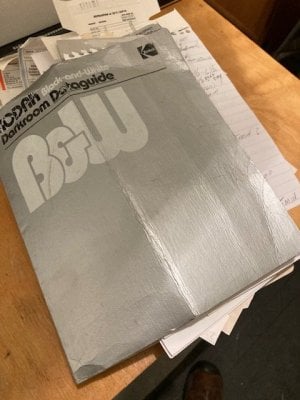 F26016DD-DD32-4B41-B7C2-E7820CE729E9.jpeg65.3 KB · Views: 5
F26016DD-DD32-4B41-B7C2-E7820CE729E9.jpeg65.3 KB · Views: 5 -
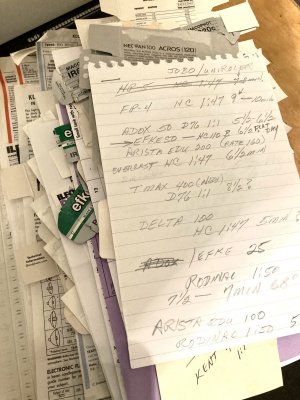 F4A9D74E-99E1-4580-9337-EDEF39367DB8.jpeg316.9 KB · Views: 5
F4A9D74E-99E1-4580-9337-EDEF39367DB8.jpeg316.9 KB · Views: 5 -
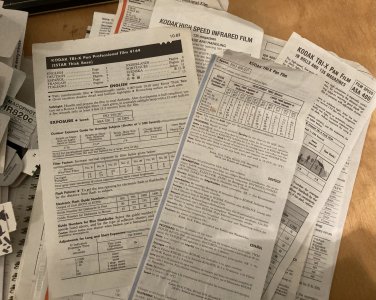 2AA13772-DF5E-4703-B750-3966CCF0612D.jpeg500.9 KB · Views: 5
2AA13772-DF5E-4703-B750-3966CCF0612D.jpeg500.9 KB · Views: 5
Pál_K
Cameras. I has it.
ColorPlus seems to be a revival of the old Kodacolor or VR film - I don’t know why they revived it because it seems to be a step backwards. I think the Gold was best (in spite of the somewhat arrogant name) in terms of balancing vibrancy and saturation vs. trying to maintain a neutral palette.I always found ColorPlus to just be wildly inconsistent. Sometimes you'd get something that was half-way passable, and often you'd get the strawberry faces @Dogman mentioned - especially if there was any hint of underexposure.
Underexposure, though, produces muddy tones. I usually overexpose one stop.
Last edited:
How did you cut it down to 100?Crazy film world indeed. I just bought 400 feet of Kodak XX and rigged a split reel to spool it down to 100'. Even that wasn't cheap.
Been pondering a 400 ft roll of Vision 3…
PRJ
Another Day in Paradise
I saw Colorplus selling for something like $17 a roll at BH last week. At that rate, Kodak won't have to worry about keeping up with demand.
The golden days and the resurgence of film I think are both over now. If I didn't still prefer darkroom prints I'd probably throw in the towel. Black and white film is still reasonable all things considered. I sometimes think about just buying a whole ton of XX and tossing it in the freezer. Maybe 5 1000' rolls would do it.
The golden days and the resurgence of film I think are both over now. If I didn't still prefer darkroom prints I'd probably throw in the towel. Black and white film is still reasonable all things considered. I sometimes think about just buying a whole ton of XX and tossing it in the freezer. Maybe 5 1000' rolls would do it.
PRJ
Another Day in Paradise
I use a movie film rewinder and 100' spools I have left over from years of bulk loading. It goes really fast that way. You can just use film cores but that can get sloppy and you'd need an adapter. The last batch of Ilford bulk film I bought was on cores instead of spools. Probably cheaper that way for them. Not so good for us though.How did you cut it down to 100?
Been pondering a 400 ft roll of Vision 3…
raydm6
Yay! Cameras! 🙈🙉🙊┌( ಠ_ಠ)┘ [◉"]
What would be the most expensive film right now?
I see Provia 8x10 (20 sheets) at $400 per box ($20/exposure) before processing.
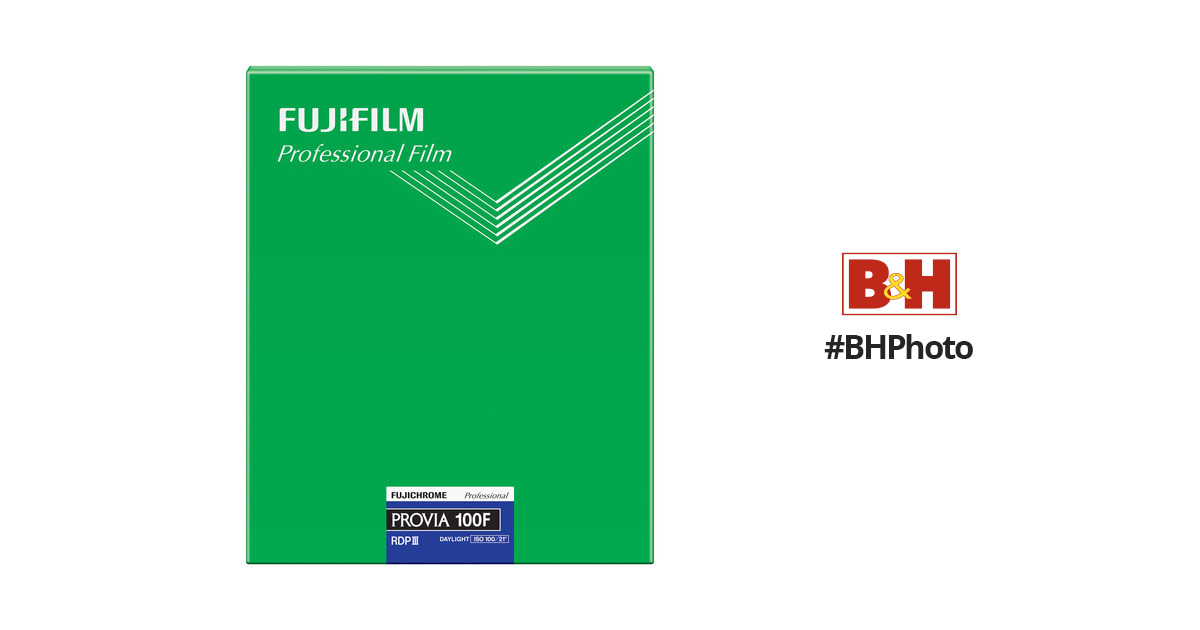
 www.bhphotovideo.com
www.bhphotovideo.com
I see Provia 8x10 (20 sheets) at $400 per box ($20/exposure) before processing.

FUJIFILM Fujichrome Provia 100F Professional RDP-III Color Transparency Film (8 x 10", 20 Sheets)
Buy FUJIFILM Fujichrome Provia 100F Professional RDP-III Color Transparency Film (8 x 10", 20 Sheets) featuring Daylight-Balance Color Transparency Film, ISO 100/21° in E-6/CR-56/C6R Process, Super-Fine Grain Structure, Vivid and Natural Colors, Rich Tone Reproduction, Push/Pull Processing to...
Out to Lunch
Menteur
This must be the 'whatever the fool pays' special 
titrisol
Bottom Feeder
Not so long ago, you could buy a 100ft (30m) roll of Foma or EFKE for less than $40
titrisol
Bottom Feeder
I recently bought some DoubleX from a user that splits 400ft rolls.How did you cut it down to 100?
Been pondering a 400 ft roll of Vision 3…
Earlier (2007), I bought a "short-end" that ended up being over 100ft and barely fit in the Lloyds
Dogman
Mentor
Appropriately, I was rummaging around in a drawer looking for something this morning and hit the jackpot. Found an unexposed roll of Kodak Gold! Also the Olympus Stylus Epic I bought for my wife (that she hardly used) along with a few coins and assorted stuff.
Coldkennels
Barnack-toting Brit.
Foma's stuff is still very reasonably priced. I picked up a shorter bulk roll - 17m - of Foma 100 for £32 last October to give it a proper try before I commit to the full 30.5m.Not so long ago, you could buy a 100ft (30m) roll of Foma or EFKE for less than $40
Rollei's pretty reasonable, too. I grabbed a 30.5m roll of Retro 400S for £54 last month; It's just Kodak that's gone absolutely mad.
I have only one 100' spool. Wish I had saved others...I use a movie film rewinder and 100' spools I have left over from years of bulk loading. It goes really fast that way. You can just use film cores but that can get sloppy and you'd need an adapter. The last batch of Ilford bulk film I bought was on cores instead of spools. Probably cheaper that way for them. Not so good for us though.
Could 100 feet be spooled onto that, and the remaining 300 left for later?
Sorry for the dumb questions, but what's a core vs a spool?
x-ray
Mentor
You have to be careful using winders. In dry weather film can build up static electricity and cause streaks and flashes on the film. I’ve had it happen before in the darkroom. You can actually see it happening.I use a movie film rewinder and 100' spools I have left over from years of bulk loading. It goes really fast that way. You can just use film cores but that can get sloppy and you'd need an adapter. The last batch of Ilford bulk film I bought was on cores instead of spools. Probably cheaper that way for them. Not so good for us though.
A company I worked for in the early 70’s had a bunch of Hasselblad EL’s with 70mm backs. During very cold dry weather the cameras transported film fast enough to build up static and cause lightning flashes which ruined your film. It actually looks like bolts of lightning on the film when you process it.
That's one reason Vision 3 has remjet, to eliminate the effect of static electricity in 24fps movie cameras. Don't think I would be capable of manually rewinding at that speed!
Saganich
Established
This is the rig I made mostly from stuff I had lying around. I purchased a 35mm split reel and a 16mm rewinder with clamp almost 2 years ago when I first thought about doing this. 100' split reels are impossible to find, I think this one is 1000' split reel. At first I was going to rig this in the traditional upright position, but then It occurred to me that I could clamp the 16mm rewinder face down. Then the bulk reel and spool would be better secured. I was nervous about dumping the entire bulk role on the floor. I have allot of thick Plexiglas lying around so that's what I used instead of plywood. I added a spindal made from a small bolt to secure the split reel and clamped the rewind an L shaped piece of plexi. I also clamped both pieces to the table (not shown) with wood clamps so things wouldn't move around in the dark. The 400' XX come on a proper movie film core. The film goes into the split reel and either I spool onto a bulk film core or onto an old microfilm reel. The reels are easier. For the core I rigged a mayojar top with piece of tubing for a spacer so the film stays put while winding. The first time, I did not use the jar top and had to stop every 3 turns the push the film down and cut my finger once, film edge is sharp when moving, and once you stop winding starting the wind is difficult once the reel is past an inch, probably because of the orientation. I estimated length by number of turns on the rewind or I just filled the spool to nearly the top. After spooling I put the film directly in a bulk loader or seal it into a can depending if I have cans and black bags available. The reels fit into the bulk loaders btw but may be a bit finicky closing them up. Currently I have 120' roll and a 50'roll in the original 400' can. Generally I get 3 spools at 120' and the 4th around 50'. I could be more accurate I suppose.
Attachments
Share:
-
This site uses cookies to help personalise content, tailor your experience and to keep you logged in if you register.
By continuing to use this site, you are consenting to our use of cookies.


